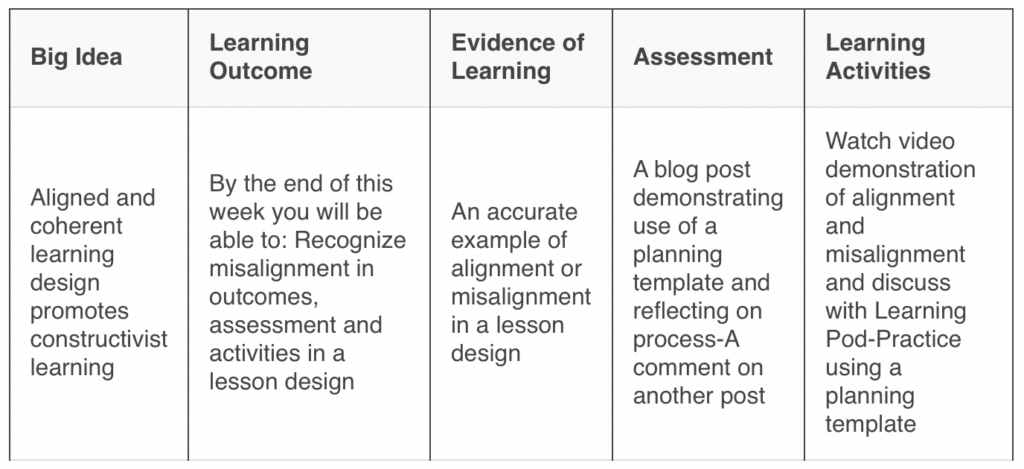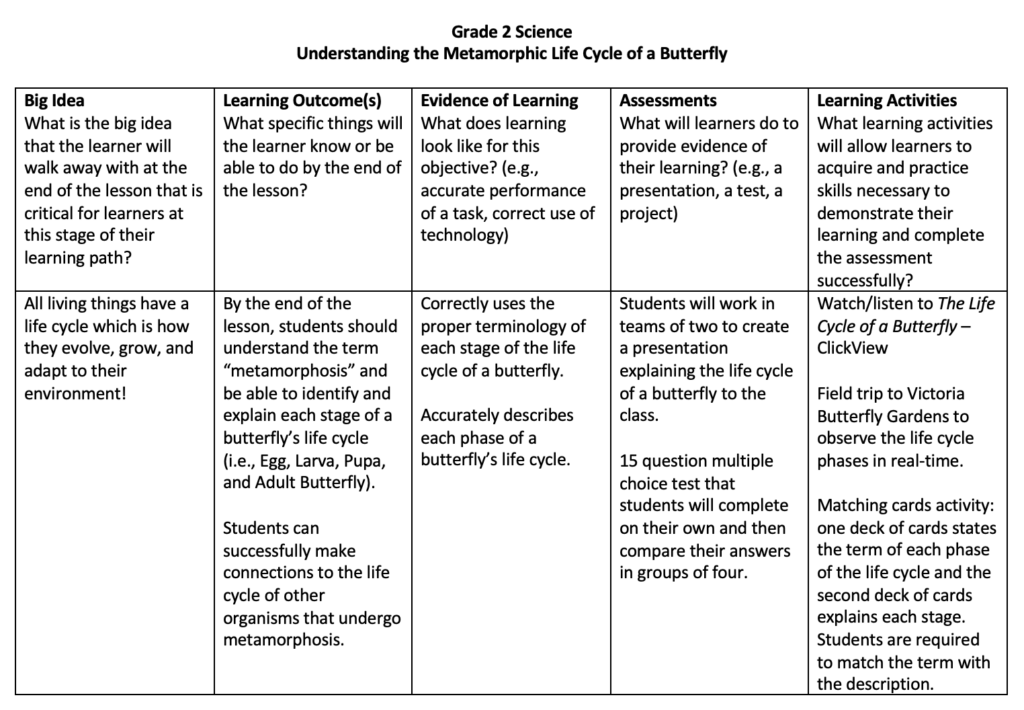This week I learned about various instructional design techniques such as constructive alignment and backwards design that will effectively support the learning of students. Constructive alignment is the combination of two principles: alignment and constructivism. Alignment refers to the consistent relationship between what content the students will learn, how this information is taught by teachers, and how students will be assessed. Constructivism within this instructional design refers to the notion that students develop knowledge instead of having it conveyed to them by teachers. Backwards design is when you begin with your desired results, followed by a plan for how to measure those results, and then develop activities to prepare students for evaluations. As shown below, I have created a grade 2 science lesson regarding the metamorphic life cycle of a butterfly utilizing constructive alignment and Merill’s five principles of instructional design.
Example of Constructive Alignment:

My Science Lesson:

Learning outcomes retrieved from BC Curriculum – Science 2.
Merril’s Five Principles Applied to Grade 2 Science Lesson
- Learner is engaged in solving real-world problems
- The real-world problem in this Grade 2 science lesson is “what is the metamorphic life cycle of a butterfly?”
- Begin lesson with an overview of the topic and an outline for what will be learned.
- Students will activate prior knowledge and experiences to promote learning
- To activate prior knowledge, there will be a discussion to review living versus non-living things and the characteristics and adaptations of species within a local environment (prior knowledge from BC Curriculum – Grade 1 Science).
- Students will then watch The Life Cycle of a Butterfly by ClickView.
- Instruction demonstrates new knowledge to learners
- Presentation created by the instructor on the definition of metamorphosis and the different phases of a butterfly’s life cycle.
- Through a field-trip to Victoria Butterfly Gardens, students will have the opportunity to observe butterflies in their different stages of life in real-time. Instructors will create a work sheet that students can fill out while observing the butterflies to make connections to course content. It is important for students to learn outside of the classroom which offers a more hands-on and immersive experience.
- Learners apply new knowledge to solve problems
- Through a card game activity created by the instructor, students are asked to match the description of each phase of the life cycle to the correct term.
- Students will work in groups of two to create a presentation describing each phase of the life cycle in their own words.
- A short multiple choice test will evaluate the student’s understanding of concepts learned in class. Students will first complete the test on their own and then compare their in groups of four.
- Learners integrate new knowledge into their everyday life
- Students should be able to make connections to other living organisms such as a frog that also undergo metamorphosis.
- Students should recognize that every living organism has a life cycle and why it is important.
Constructive Alignment and Backwards Design in my Courses:
When reflecting on my own learning, I believe the majority of my biology classes somewhat use a backwards and constructive alignment approach however this need to be significantly improved in the future. For instance, when starting a new topic my professors always begin with a slide talking about the learning outcomes and what students are expected to know by the end of the topic. However, this is always followed by a series of lectures and examinations. The information within these biology classes are conveyed directly to students from teachers through lectures and there are no opportunities for students to develop the knowledge on their own. In addition, my professors do not develop activities to prepare students for examinations or find new ways to measure our learning as course content is always depicted through lectures and we are always tested on content through exams.
Resources
Merrill, M. D. (2002). First Principles of Instruction. ETR&D, 50, 3. pp. 43-59.
Leave a Reply
You must be logged in to post a comment.